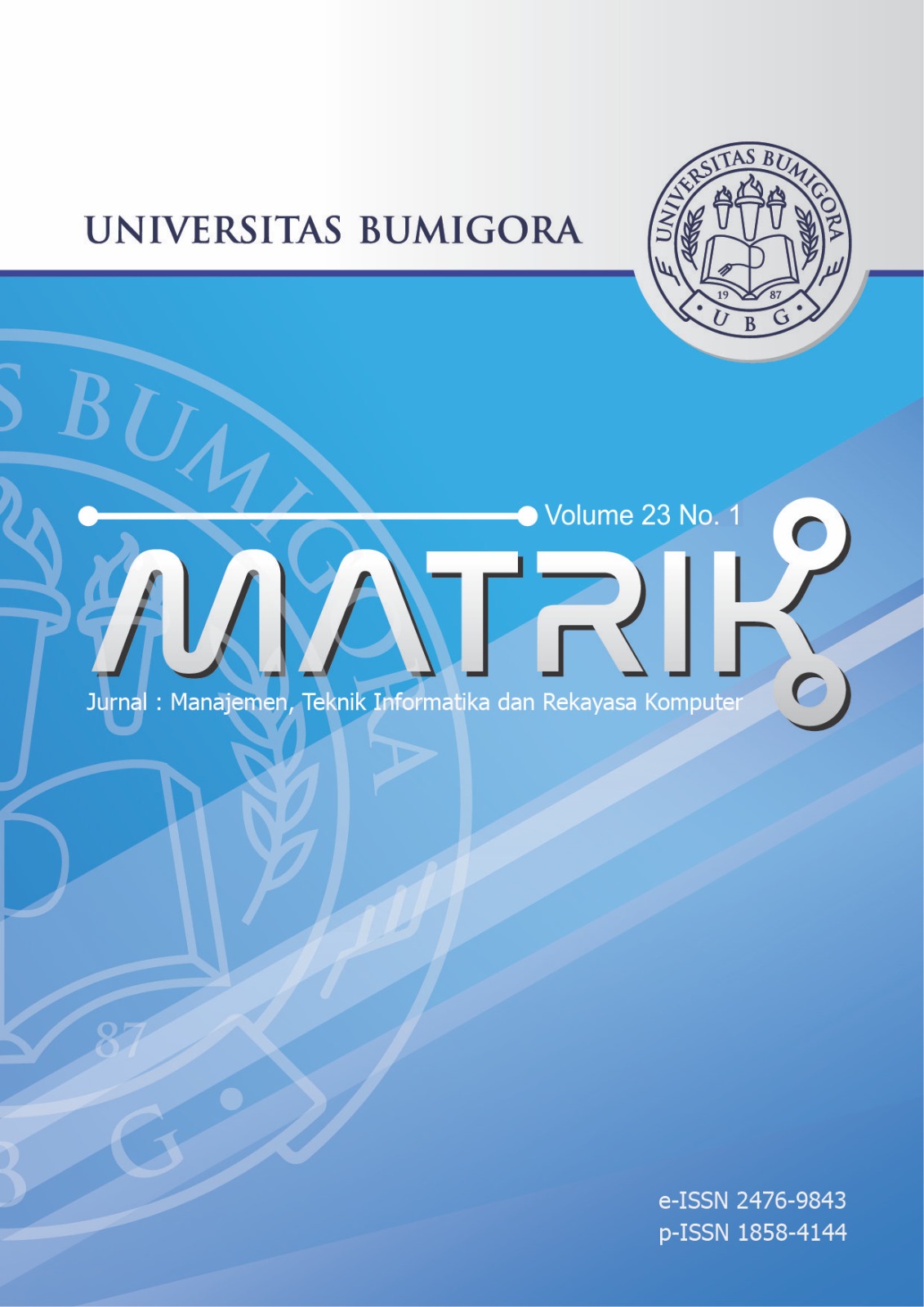Feature Selection on Grouping Students Into Lab Specializations for the Final Project Using Fuzzy C-Means
DOI:
https://doi.org/10.30812/matrik.v23i1.3341Keywords:
Cluster, Fuzzy C-means, Silhouette Coefficient, Pearson Correlation, Principal Componen AnalysisAbstract
The student’s Final Project is critical as a requirement to graduate from the University. In the PSTI at Mataram University, each student is required to choose a specialization lab to focus on the final project topic that they will work on. From the questionnaire, 57.7% of students answered that it is difficult to select a lab, and others answered that they prefer to determine the labs based on the grades of the courses that represent each lab. This research aimed to group and analyze students in the final project specialization lab by using the main method, namely Fuzzy C-Means (FCM). The methods used were FCM for clustering, Silhouette Coefficient for analysis of cluster quality results, Pearson Correlation, and Principal Component Analysis for the feature selection processing. The results of this study showed that the FCM method followed by a method for feature selection has better results than previous studies that used the K-Means method without feature selection; with this research result using 131 data, the cluster validation result is 0.501, after feature selection using Pearson correlation is 0.534. Thus, Fuzzy C-Means followed by the right feature selection method can group students into specialization laboratories with good results and can be further developed.
Downloads
References
for Millennial Generation in Higher Education,†Utamax : Journal of Ultimate Research and Trends in Education, vol. 4, no. 2,
pp. 84–100, 2022.
[2] C. D. Safitri, S. Azisah, and M. J. Annur, “The Analysis of Students’ Challenges To Thesis Writing at UIN Alauddin Makassar,â€
English Language Teaching for EFL Learners, vol. 3, no. 2, pp. 41–53, sep 2021.
[3] J.-C. Chang, Y.-T. Wu, and J.-N. Ye, “A Study of Graduate Students’ Achievement Motivation, Active Learning, and Active
Confidence Based on Relevant Research,†Frontiers in Psychology, vol. 13, no. June, pp. 1–10, jun 2022.
[4] D. Nirmala and E. P. Hendro, “Problema Dalam Memilih Judul Penelitian Kebahasaan Bagi Pemula,†Jurnal Harmoni, vol. 5,
no. 1, pp. 15–19, 2020.
[5] N. Nurfaizah and F. Fathuzaen, “Clustering Customer Data Using Fuzzy C-Means Algorithm,†PIKSEL : Penelitian Ilmu Komputer
Sistem Embedded and Logic, vol. 9, no. 1, pp. 1–14, 2021.
[6] N. A. Ningrum and M. A. Syaputra, “Penerapan Metode Fuzzy C-Means untuk Penentuan Kompetensi Mahasiswa di STMIK
Dharmawacana Metro,†Journal Computer Science and Informatic Systems:J-Cosys, vol. 2, no. 1, pp. 1–7, 2022.
[7] P. Subekti, T. D. Andini, and M. Islamiyah, “Sistem Penentuan Konsentrasi Jurusan Bagi Mahasiswa Informatika Menggunakan
Metode K-Means Di Institut Asia Malang,†Jurnal Manajemen Informatika (JAMIKA), vol. 12, no. 1, pp. 25–39, 2022.
[8] H. K. Candra, M. Bahit, and B. Sabella, “Penerapan Metode Klustering Fuzzy C-Means Untuk Penentuan Peminatan Pemilihan
Jurusan Pada Sekolah Menengah Tingkat Atas,†POSITIF : Jurnal Sistem dan Teknologi Informasi, vol. 7, no. 2, pp. 108–119,
2021.
[9] H. Haviluddin, S. J. Patandianan, G. M. Putra, N. Puspitasari, and H. S. Pakpahan, “Implementasi Metode K-Means Untuk
Pengelompokkan Rekomendasi Tugas Akhir,†Informatika Mulawarman : Jurnal Ilmiah Ilmu Komputer, vol. 16, no. 1, pp.
13–18, mar 2021.
[10] A. Abdullah and S. Sucipto, “Sistem Pendukung Keputusan Untuk Rekomendasi Topik Skripsi Dengan Metode Fuzzy AHP,â€
Jurnal Transformatika, vol. 18, no. 2, pp. 231–239, jan 2021.
[11] Antoni Erga and Y. Nataliani, “Seleksi Fitur Pada Pengelompokkan Posisi Pemain Basket Menggunakan Fuzzy C-Means,â€
Journal Of Information Technology and Computer Science, vol. 3, no. 1, pp. 77–84, 2021.
[12] J. Mantik, D. Hartama, and M. Anjelita, “Analysis of Silhouette Coefficient Evaluation with Euclidean Distance in the Clustering
Method (Case Study: Number of Public Schools in Indonesia),†Jurnal Mantik, vol. 6, no. 3, pp. 3667–3677, 2022.
[13] Winarno, “Comparison Of Clustering Levels Of The Learning Burnout Of Students Using The Fuzzy C-Means And K-Means
Methods,†Jurnal Teknologi Informasi dan Pendidikan, vol. 16, no. 1, pp. 38–53, 2023.
[14] D. E. Parson, “Research Commons at Kutztown University Hawk Mountain Raptor Migration Phenology ’ s Relation toWeather
Hawk Mountain Raptor Migration Phenology ’ s Relation to Weather,†2023.
[15] P. Chen, F. Li, and C.Wu, “Research on Intrusion Detection Method Based on Pearson Correlation Coefficient Feature Selection
Algorithm,†Journal of Physics: Conference Series, vol. 1757, no. 1, pp. 1–10, jan 2021.
[16] R. Pujianto, Adiwijaya, and A. A. Rahmawati, “Analisis Ekstraksi Fitur Principle Component Analysis pada Klasifikasi Microarray
Data Menggunakan Classification And Regression Trees,†eProceedings . . . , vol. 6, no. 1, pp. 2368–2379, 2019.
Downloads
Published
Issue
Section
How to Cite
Similar Articles
- Saiful Nur Arif, Muhammad Dahria, Sarjon Defit, Dicky Novriansyah, Ali Ikhwan, Implementation of Single Linked on Machine Learning for Clustering Student Scientific Fields , MATRIK : Jurnal Manajemen, Teknik Informatika dan Rekayasa Komputer: Vol. 22 No. 1 (2022)
- Desi Vinsensia, Siskawati Amri, Jonhariono Sihotang, Hengki Tamando Sihotang, New Method for Identification and Response to Infectious Disease Patterns Based on Comprehensive Health Service Data , MATRIK : Jurnal Manajemen, Teknik Informatika dan Rekayasa Komputer: Vol. 23 No. 3 (2024)
- Ismail Husein, Rina Widyasari, Algorithm Symmetric 2-DLDA for Recognizing Handwritten Capital Letters , MATRIK : Jurnal Manajemen, Teknik Informatika dan Rekayasa Komputer: Vol. 21 No. 2 (2022)
- Angelina Ervina Jeanette Egeten, Lya Santi Rahayu, Riansyah Rafsanjani, Analisis dan Perancangan Sistem Reservasi Paket Wisata Untuk Internal Karyawan PT. Garuda Maintenance Facility (GMF) Tbk , MATRIK : Jurnal Manajemen, Teknik Informatika dan Rekayasa Komputer: Vol. 19 No. 1 (2019)
- Ahmad Zein Al Wafi, Febry Putra Rochim, Veda Bezaleel, Investigating Liver Disease Machine Learning Prediction Performancethrough Various Feature Selection Methods , MATRIK : Jurnal Manajemen, Teknik Informatika dan Rekayasa Komputer: Vol. 24 No. 3 (2025)
- Angelina Ervina Jeanette Egeten, Siska A. Damanik, Ika Agustina, Marcelina Panggabean, Perancangan Sistem Informasi Posyandu Berbasis Web Pada Yayasan Kalyanamitra Di Jakarta Timur Untuk Mendukung Program Bidang Pendampingan Komunitas , MATRIK : Jurnal Manajemen, Teknik Informatika dan Rekayasa Komputer: Vol. 18 No. 2 (2019)
- Hermila A., Rahmat Taufik R. L Bau, Sitti Suhada, Abdulaziz Ahmed siyad, Predicting Gen Z’s Sentiments on Gorontalo’s CulturalWisdom UsingSentiment Analysis Models , MATRIK : Jurnal Manajemen, Teknik Informatika dan Rekayasa Komputer: Vol. 24 No. 2 (2025)
- Lalu Ganda Rady Putra, Anthony Anggrawan, Pengelompokan Penerima Bantuan Sosial Masyarakat dengan Metode K-Means , MATRIK : Jurnal Manajemen, Teknik Informatika dan Rekayasa Komputer: Vol. 21 No. 1 (2021)
- Bobby Poerwanto, Baso Ali, Implementasi Algoritma Fuzzy C-Means dalam Mengelompokkan Kecamatan di Tana Luwu Berdasarkan Produktifitas Hasil Perkebunan , MATRIK : Jurnal Manajemen, Teknik Informatika dan Rekayasa Komputer: Vol. 19 No. 1 (2019)
- Frans Mikael Sinaga, Sio Jurnalis Pipin, Sunaryo Winardi, Karina Mannita Tarigan, Ananda Putra Brahmana, Analyzing Sentiment with Self-Organizing Map and Long Short-Term Memory Algorithms , MATRIK : Jurnal Manajemen, Teknik Informatika dan Rekayasa Komputer: Vol. 23 No. 1 (2023)
You may also start an advanced similarity search for this article.
Most read articles by the same author(s)
- Nurun Latifah, Ramaditia Dwiyansaputra, Gibran Satya Nugraha, Multiclass Text Classification of Indonesian Short Message Service (SMS) Spam using Deep Learning Method and Easy Data Augmentation , MATRIK : Jurnal Manajemen, Teknik Informatika dan Rekayasa Komputer: Vol. 23 No. 3 (2024)
- Gibran Satya Nugraha, Hairani Hairani, Aplikasi Pemetaan Kualitas Pendidikan di Indonesia Menggunakan Metode K-Means , MATRIK : Jurnal Manajemen, Teknik Informatika dan Rekayasa Komputer: Vol. 17 No. 2 (2018)


.png)












